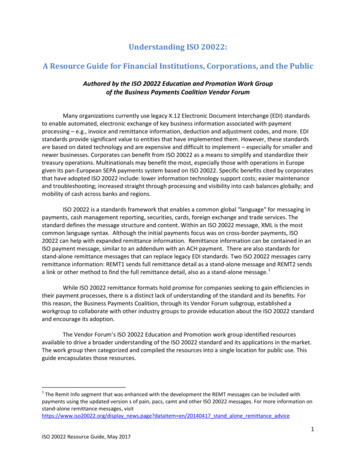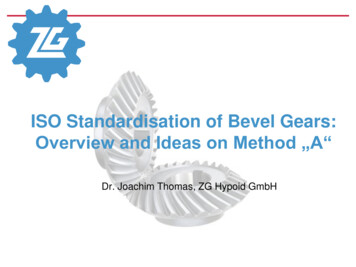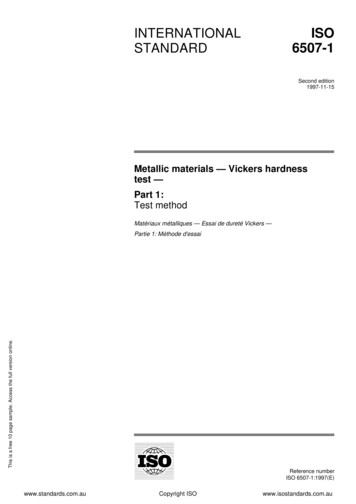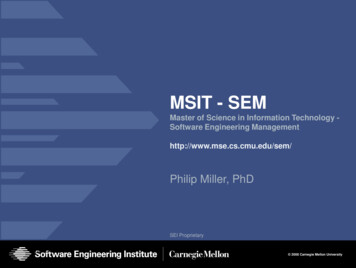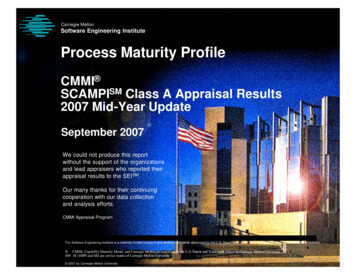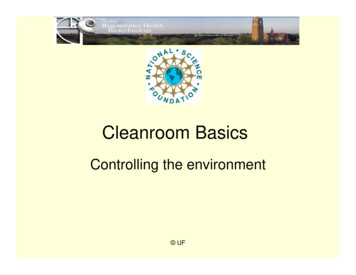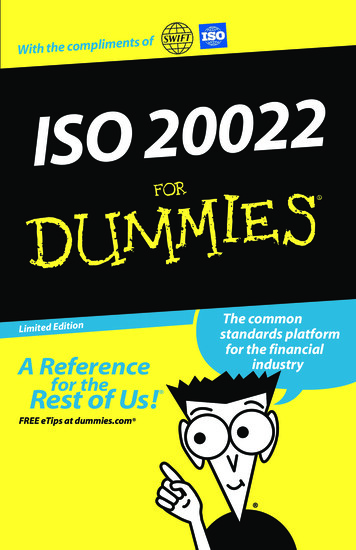
Transcription
ts ofWith the complimen22002ISOThe commonstandards platformfor the financialindustryLimited EditionA Referencefor theRest of Us!FREE eTips at dummies.com
ISOISO is the International Organization for Standardization. It has a membership of161 national standards bodies (NSBs) from countries large and small, industrialized,developing and in transition, in all regions of the world. ISO’s portfolio of more than18,100 standards provides business, government and society with practical toolsfor all three dimensions of sustainable development: economic, environmentaland societal.ISO International Standards make a positive contribution to the world we live in. Theyfacilitate trade, spread knowledge, disseminate innovative advances in technologyand share good management and conformity assessment practice.ISO supports this book, which has been prepared by SWIFT as a useful source ofinformation for current and potential users of ISO 20022.ISO/TC 68, Financial servicesISO 20022 was developed and is maintained by ISO/TC 68, the ISO technicalcommittee responsible for standardization in the field of banking, securitiesand other financial services. Its curent portfolio consists of 49 standards or relateddocuments and its membership comprises the NSBs of 28 countries, plus thefollowing stakeholder organizations: CEFACT, ECB, MasterCard, SWIFT, TWIST,UNECE, VISA.International Organization for Standardization, ISO:www.iso.org
ISO 20022FORDUMmIES‰by The SWIFT Standards TeamA John Wiley and Sons, Ltd, Publication
ISO 20022 For Dummies Published byJohn Wiley & Sons, LtdThe AtriumSouthern GateChichesterWest SussexPO19 8SQEnglandFor details on how to create a custom For Dummies book for your business or organisation, contactCorporateDevelopment@wiley.com. For information about licensing the For Dummies brand forproducts or services, contact BrandedRights&Licenses@Wiley.com.Visit our Home Page on www.customdummies.comCopyright 2010 by John Wiley & Sons Ltd, Chichester, West Sussex, EnglandAll Rights Reserved. No part of this publication may be reproduced, stored in a retrieval system ortransmitted in any form or by any means, electronic, mechanical, photocopying, recording, scanningor otherwise, except under the terms of the Copyright, Designs and Patents Act 1988 or under theterms of a licence issued by the Copyright Licensing Agency Ltd, 90 Tottenham Court Road, London,W1T 4LP, UK, without the permission in writing of the Publisher. Requests to the Publisher for permission should be addressed to the Permissions Department, John Wiley & Sons, Ltd, The Atrium,Southern Gate, Chichester, West Sussex, PO19 8SQ, England, or emailed to permreq@wiley.com,or faxed to (44) 1243 770620.Trademarks: Wiley, the Wiley Publishing logo, For Dummies, the Dummies Man logo, A Referencefor the Rest of Us!, The Dummies Way, Dummies Daily, The Fun and Easy Way, Dummies.com andrelated trade dress are trademarks or registered trademarks of John Wiley & Sons, Inc. and/or itsaffiliates in the United States and other countries, and may not be used without written permission.All other trademarks are the property of their respective owners. Wiley Publishing, Inc., is not associated with any product or vendor mentioned in this book.LIMIT OF LIABILITY/DISCLAIMER OF WARRANTY: THE PUBLISHER, THE AUTHOR, ANDANYONE ELSE INVOLVED IN PREPARING THIS WORK MAKE NO REPRESENTATIONS OR WARRANTIES WITH RESPECT TO THE ACCURACY OR COMPLETENESS OF THE CONTENTS OF THISWORK AND SPECIFICALLY DISCLAIM ALL WARRANTIES, INCLUDING WITHOUT LIMITATIONWARRANTIES OF FITNESS FOR A PARTICULAR PURPOSE. NO WARRANTY MAY BE CREATEDOR EXTENDED BY SALES OR PROMOTIONAL MATERIALS. THE ADVICE AND STRATEGIES CONTAINED HEREIN MAY NOT BE SUITABLE FOR EVERY SITUATION. THIS WORK IS SOLD WITHTHE UNDERSTANDING THAT THE PUBLISHER IS NOT ENGAGED IN RENDERING LEGAL,ACCOUNTING, OR OTHER PROFESSIONAL SERVICES. IF PROFESSIONAL ASSISTANCE ISREQUIRED, THE SERVICES OF A COMPETENT PROFESSIONAL PERSON SHOULD BE SOUGHT.NEITHER THE PUBLISHER NOR THE AUTHOR SHALL BE LIABLE FOR DAMAGES ARISING HEREFROM. THE FACT THAT AN ORGANIZATION OR WEBSITE IS REFERRED TO IN THIS WORK ASA CITATION AND/OR A POTENTIAL SOURCE OF FURTHER INFORMATION DOES NOT MEANTHAT THE AUTHOR OR THE PUBLISHER ENDORSES THE INFORMATION THE ORGANIZATIONOR WEBSITE MAY PROVIDE OR RECOMMENDATIONS IT MAY MAKE. FURTHER, READERSSHOULD BE AWARE THAT INTERNET WEBSITES LISTED IN THIS WORK MAY HAVE CHANGEDOR DISAPPEARED BETWEEN WHEN THIS WORK WAS WRITTEN AND WHEN IT IS READ.Wiley also publishes its books in a variety of electronic formats. Some content that appears in printmay not be available in electronic books.ISBN: 978-0-470-97282-3Printed and bound in Great Britain by Page Bros, Norwich10 9 8 7 6 5 4 3 2 1
AcknowledgementsThe authors would like to thank all the members of the SWIFTStandards team that contributed to the content of this book,and who did a great job of collating and interpreting reviewcomments from around the community. We would also like tothank the following SWIFT people that contributed their timeand expertise: Gottfried Leibbrandt, Martine DeWeirdt, RosieHalfhead and Kim Bratanata.We would also like to extend our thanks to those members ofthe SWIFT and ISO communities that took the time to reviewan early draft of the book and offer their comments: AndreasSchneider (BHF), John Masterson (BoNY-Mellon), RuneOlofsson (Nordea), Mike Tagai (JPM-Chase), Javier Santamaria(Santander), Loretta Briano (SanPaulo) and Peter Potgieser(RBS). Finally, we would like to thank Nicolas Fleury and hiscolleagues at ISO for the Introduction, and Karla McKenna(Citi) for providing valuable feedback and for writing theForeword.
ForewordThe financial services industry has a unique opportunity.Despite all of the intricacies of our business processes andtransaction types, our industry has the opportunity to identifyand promote interoperable business processes that containrisk, reduce cost and deliver effective products and solutions.How can we achieve this? Through leveraging the process thatis the ISO 20022 standard – a standard that our industry hasdeveloped, adopted and continues to improve.We can define and hold the basic foundations of our businesses in a common repository and data dictionary and derivethe financial messaging that we use from these tools. We canleverage current technical advances and adapt to future technical change. This foresight and flexibility is built into the ISO20022 standard.As standards professionals, and more importantly, as businessmanagers, we need to raise the awareness and provide industry participants with the knowledge that they need to improve,grow and sustain their businesses in the long-term.Thank you to SWIFT both as a constant and dedicated memberof the ISO process and for this valuable book, which can contribute to the achievement of a smooth, managed transitionand adoption of the ISO 20022 standard.Karla McKennaChairISO TC68, Financial Services
Publisher’s AcknowledgementsWe’re proud of this book; please send us your comments through our Dummies onlineregistration form located at www.dummies.com/register/.Some of the people who helped bring this book to market include the following:Acquisitions, Editorial and MediaDevelopmentCorporate & Custom Publishing:Scott SmithProject Editor: Jo TheedomDevelopment Editor: Simon BellExecutive Project Editor: Daniel MerseyComposition ServicesProject Coordinator: Lynsey StanfordLayout and Graphics:Samantha K. Cherolis
IntroductionWhile many people in the financial services industryhave heard about ISO 20022, few truly understandwhat it is about and what is so great about it. We at SWIFTare convinced that ISO 20022 can bring profound benefitsto the financial services industry, as it realises end-to-endprocessing across domains and geographies that currentlyuse vastly different standards and information formats. Thisbook removes the mystery from ISO 20022, helps you understand why it matters, and lets you see how you can benefitfrom it.Foolish AssumptionsThis book makes some foolish assumptions about you, thepeople who read it: You are interested in information processing in the financial services industry. You know something about how the financial industryworks. You have heard about ISO 20022 and you want to knowmore: what it aims to do; who uses it and why; how touse it yourself. You want to contribute to the ISO 20022 effort.While some knowledge of the industry and the use of information processing might be helpful when reading this book, weexplain all the concepts and terms when we first introducethem. In addition, we have added a glossary of terms andacronyms in the appendix.
2ISO 20022 For DummiesHow to Use This BookThis book comprises five parts and a Glossary. If you don’thave time to read the whole book, we suggest you flip toChapters 5 and 6 and read the summaries: Ten Great Thingsabout ISO 20022 and Almost Ten Things to Tell Your CIOabout ISO 20022. Chapter 1: What Is ISO 20022? This part introduces thekey concepts of financial messaging, explains where ISO20022 fits in, and outlines what makes it different fromother standards. Chapter 2: ISO 20022 in Practice. This part focuses onthe use of ISO 20022 – where it is currently being used,and for what; it also contains some helpful advice onimplementation. Chapter 3: The ISO 20022 Organisation. Here we explainthe ISO organisation, and describe the various committees and working groups that together define, maintainand promote the standard. Chapter 4: ISO 20022 and SWIFT: SWIFT is a major contributor to ISO 20022 on many fronts. This part describesSWIFT’s long relationship with the standard, and theservices that SWIFT can offer to help implementers andcontributors. Chapter 5: Ten Great Things about ISO 20022: Finally,we give you ten good reasons why ISO20022 is good foryou and good for your business. Chapter 6: Almost Ten Things to Tell Your CIO aboutISO 20022: A summary of the key points in the book. Chapter 7: Ten Useful Links for Standards Implementers.Find websites to further your understanding.Dip in and out of the book as you wish. You can go to anychapter that looks interesting, or read it from front to back.
Introduction3Icons Used in This BookThe Dummies man indicates examples to illustrate a point andinspire you.The target signifies particularly useful advice.The knotted string highlights important information to bear inmind.Where to Go from HereCheck out the section headings in this book and start readingwhichever ones interest you the most. This book is writtenwith sequential logic, but if you’d prefer to skip ahead to theinformation you need rather than read it from cover to cover,feel free to do so.
4ISO 20022 For Dummies
Chapter 1What Is ISO 20022?In This Chapter Introducing financial messaging standards ISO 20022 and how it is differentIn essence, ISO 20022 is a recipe for making financial messaging standards. But before we go much further, weshould say what financial messaging standards are, so that’swhat this Part starts off by doing. We come to ISO 20022 itselflater in the Part.What Are Financial MessagingStandards?To conduct their business, financial institutions exchangemassive amounts of information with their customers andamong themselves. Such exchanges only work if the senderand receiver of a message have a common understanding ofhow to interpret this information. This is especially true ifeither party wishes to rely entirely on computers to processinformation.Grasping the basics: syntaxand semanticsTo be able to eliminate the need for human intervention tointerpret the data, the financial industry has created messagedefinitions – that is, agreements on how to organise the data
6ISO 20022 For Dummiesthey want to exchange in structured formats (syntax) andmeaning (semantics). Based on such message definitions, theywill exchange messages, as illustrated by the following extractof a simple payment instruction.Suppose ExampleBank in Utrecht, the Netherlands (BankIdentifier Code (BIC) EXABNL2U) has been requested by itscorporate customer ACME NV, Amstel 344, Amsterdam totransfer 12,500 US Dollars on 29 October 2009 from its account8754219990. Instead of addressing the above instruction to itsUS Dollar correspondent in unstructured text, ExampleBanksends a structured message based on a standard messagedefinition: CdtTrfTxInf IntrBkSttlmAmt Ccy ‘USD’ 12500 /IntrBkSttlmAmt IntrBkSttlmDt 2009-10-29 /IntrBkSttlmDt Dbtr Nm ACME NV. /Nm PstlAdr StrtNm Amstel /StrtNm BldgNb 344 /BldgNb TwnNm Amsterdam /TwnNm Ctry NL /Ctry /PstlAdr /Dbtr DbtrAcct Id Othr Id 8754219990 /Id /Othr /Id /DbtrAcct DbtrAgt FinInstnId BIC EXABNL2U /BIC /FinInstnId /DbtrAgt /CdtTrfTxInf The above example is an excerpt from an ISO 20022 CustomerCredit Transfer.
Chapter 1: What Is ISO 20022?7Messaging standards provide clear definitions of the information and data formats (field lengths, codes, character sets)that can be exchanged between parties. The above message,for example, contains the line IntrBkSttlmAmt Ccy ‘USD’ 12500 /IntrBkSttlmAmt to indicate the currency and amount of the transaction. Theunderlying standard for a Customer Credit Transfer messagetells you that this field is mandatory, that it starts with thetag ‘‘IntrBkSttlmAmt’’, that the information in the field mustconsist of three letters (the ISO currency code) and up to 18digits for the actual amount.ISO 20022 is just one example of a standard used in the financialindustry. The following section gives some context by describing financial messaging, the standards it uses and some of theproblems posed by the multitude of such standards.So many standards, so little time‘The great thing about standards is that there are so many tochoose from’. It’s an old joke, but very relevant in the financialindustry. Many different standards exist covering differentgeographies and business areas. Many individual institutionseven use their own proprietary standards internally and/orwith their customers.This excerpt is taken from a SWIFT Single Customer CreditTransfer message (MT 103) that does more or less the sameas the ISO 20022 Customer Credit Transfer shown earlier. Youwill note that most information is the same, but the tags andthe order of the fields are different::32A:091029USD12500,:50K:/8754219990ACME NV.AMSTEL 344
8ISO 20022 For DummiesAMSTERDAMNETHERLANDS:52A: EXABNL2UHere is another example of the same information, this timeusing the Fedwire proprietary standard:{1520}20091029xxxxxxxxyyyyyy {2000}000001250000{5000}D8754219990ACME NV.*AMSTEL 344*AMSTERDAM*NETHERLANDS* {5100}BEXABNL2U*All of the above examples provide the same information, eachusing a different standard.Processes and value chains in financial services often coverdifferent geographical and business areas. The proliferation ofdifferent messaging standards in the financial industry createsproblems in automating these end-to-end chains. Two significant barriers exist to a common understanding of informationshared by the people and computers involved in such processes: the use of different syntaxes (structure) and the use ofdifferent semantics (meaning).The syntax barrierThe syntax is the format in which the information in a message is structured. Unless the reader understands a specificsyntax, it will not be possible to understand the message content. There is a lot of confusion about the difference betweena standard and a syntax. The standard describes the agreement on what information is expressed, while the syntax isthe format, or the ‘language’ used to express that information.It is difficult for two people to have a conversation unless theyboth use and understand the same language. The same is truefor syntax. Globalisation and the ever increasing need for endto-end processing increases the problem.In ISO 20022, the most widely used syntax is eXtensibleMark-up Language (XML). The use of short tag names (like PstlAdr to represent a postal address) is also part of thesyntax.
Chapter 1: What Is ISO 20022?Some widely used existing standards ISO 15022 is currently the predominant securities standard incross-border settlement, reconciliation and corporate actionprocessing. It was introducedaround 1998 to replace ISO 7775,which was much less structuredand often omitted crucial settlement information. The adoptionof ISO 15022, mandated in 2003,has led to a dramatic increasein Straight Through Processing(STP) rates. In settlement messages, for example, it is commonto come across STP rates ofmore than 95 per cent. One ofthe standard’s advantages is itsdata dictionary based approach,which enables reuse and standardization of data across allmessages. About half of the15 million messages that areexchanged on the SWIFT network every day are ISO 15022. ISO 8583 is used for almost allcredit and debit card transactions, including ATMs. Severalhundred million ISO 8583 messages are exchanged dailybetween issuing and acquiringbanks. FIX is the predominant standardof the securities front office.Millions of indications of interest,trade instructions, executionsetc., are sent each day using theFIX protocol. FpML stands for Financial products Markup Language. It usesthe XML syntax and was specifically developed to describe theoften complicated contracts thatform the base of financial derivative products. It is widely usedbetween broker-dealers andother securities industry players to exchange information onSwaps, CDOs, etc. SWIFT proprietary, also knownas MT messages, are the standard for messaging in correspondent banking, foreignexchange and documentarycredits. Over 9,000 financial institutions around the world use thisstandard to exchange millionsof messages per day over theSWIFT network. Proprietary domestic standardsare also widely used. DTCC isan example of a market infrastructure using proprietary standards. Each day some 40 millionmessages are exchanged withDTCC to clear and settle USdomestic securities trades. XBRL is a flexible XML basedstandard for exchanging business information, which specializes in providing easy automationfor information found in unstructured documents.9
10ISO 20022 For DummiesXML is one of the most popular syntaxes to encode documents(or messages) electronically on the Internet. XML allows communities to define their own identifiers (or tags) and format (ordata type) for each component of a message. With XML, datais marked up by using opening and closing tags that indicatethe meaning and structure of the information that is communicated. For example, Dt 2009-09-29 /Dt is an XML representation of 29 September 2009. The combination of opening andclosing tags with the data is called an element.The MT103 Single Customer Credit Transfer extract illustratedin this part uses a SWIFT proprietary syntax. It too uses tags,called field tags, to introduce data. These are alphanumericcharacters between colons. This is followed by the actualfield content. In the example, :52A: is the field tag (OrderingInstitution) and EXABNL2U is the field content.The semantic barrierOnce the syntax is out of the way, another barrier appears:the semantic barrier. Specialists in different domains orcountries have developed their own jargon or vocabularies.Different words might refer to the same concept, or worse,the same word could have different meanings.For example, what some players in the payments industry callan Ordering Customer, others refer to a Payer or Payor, whilestill others talk about a Payment Originator or Initiator. Thecontext also plays a role here: the Payment Originator/Initiatoris a Debtor/Payor in a credit transfer, while that PaymentOriginator/Initiator is a Creditor/Payee in a direct debit.These different names create difficulties when you are looking at end-to-end integration. You need (expensive) expertknowledge to understand what the specialists mean and howto reconcile the information.In order to understand the information exchanged in a particular business domain, you need to be familiar with the detailsof the specific syntaxes and the underlying semantics. Thisrequires a significant investment in time and technology.
Chapter 1: What Is ISO 20022?11ISO 20022 BasicsThe previous section sketched two barriers to a commonunderstanding of information shared between people andcomputers involved in these processes: the use of differentsyntaxes and the use of different semantics or interpretationof terms. ISO 20022 was designed to help overcome these barriers. Let’s see what makes ISO 20022 special.ISO 20022 is the agreed methodology used by the financialindustry to create consistent message standards across allthe business processes of the industry.The ISO 20022 method is based on the concept of separatelayers. We distinguish three layers: the top layer provides thekey business processes and concepts; the middle layer provides logical messages or message models; and the bottomlayer deals with syntax.Business processes and conceptsOne of the key characteristics of the ISO 20022 methodologyis that there is a distinct separation between the businessand the way it is represented in a message, that is, the syntax.The ISO 20022 methodology starts with the creation of thebusiness model. Put simply, this is the definition of theactivity or business process, the business roles and actorsinvolved in that activity and the business information neededin order for the activity to take place.The business information is organised into business components containing business elements. For example, when looking at the processes involved in a credit transfer, key notionssuch as debtor (the party that pays), creditor (the moneyreceiver), debtor agent (the bank of the debtor), creditoragent (the bank of the creditor), and payment were identified. Each of these components has further details. Figure 1-1shows a simplified business information model, representedin Unified Modeling Language (UML).
12ISO 20022 For DummiesCentral is the payment itself, which is associated with thedebtor agent and creditor agent, which are both financialinstitutions. The payment is also associated with a debtor andcreditor, which are both parties (i.e. persons or organisations,financial or other), which in turn have elements such as aname and address. Additionally, these parties may be ownersof an account. Behind these elements lie further details. Apayment, for example, contains elements such as currencyand amount, a requested execution date and settlement date,and remittance information.Logical messages independentof syntaxUsing these business concepts, ISO 20022 then defines logicalmessages, or message models, which are the middle layer.A logical message is a description of all the information thatis needed to perform a specific business activity, independentof syntax. It is composed of message components organisedin a hierarchical structure. A message component containsone or more message elements and is derived from a businesscomponent by using one, some or all of its elements. The logical message structure for the excerpt of the Customer CreditTransfer message can be seen in Figure 1-2.The message component CreditTransferTransactionInformationcontains 4 elements. Some of these, for example, Debtor andDebtorAgent, require further definition and are message components themselves. Shown here is a simplified representationthat does not show, for example, whether elements are mandatory or optional, as is normally done at this level.
ssComponentPostalAddressChapter 1: What Is ISO 20022?Figure 1-1: A simplified business information model for a paymenttransaction.13
CreditTransferTransactionInformationBIC: IdentificationDebtorAgentDebtorFigure 1-2: Part of the logical message structure for a credit transfer.Country: NLTownName: AmsterdamAddressLine: 344 AmstelPostalAddressPostalAddressName: ACME NVPartyIdentificationInterbankSettlementDate: 2009-10-09InterbankSettlementAmount: USD ent14ISO 20022 For Dummies
Chapter 1: What Is ISO 20022?15A key feature of ISO 20022 is the ability to reuse businessand message components across all messages. Whetherthe message is a credit transfer or a credit card payment, asecurities or foreign exchange transaction, the component‘PostalAddress’ can be used to express a party or financial institution’s address where appropriate. Individualelements such as ‘InterbankSettlementAmount’ and‘InterbankSettlement Date’ can also be reused.The syntaxAs stated earlier, the ISO 20022 methodology is based onthe concept of separate layers. The business model and thelogical messages are two of those layers. The third layer, thesyntax, is the physical representation of the logical message.ISO 20022 uses XML as the primary syntax and has specifiedhow to convert a message model to XML. However, in a particular business domain, a message model could be expressedin a syntax different from XML, for example, the SWIFT proprietary syntax or the FIX syntax, if agreed.It’s all in the repositoryAll of the content described so far is stored in a commonrepository.A dictionary forms part of this repository. The ISO20022 dictionary, much like the Oxford Dictionary, lists thename of a component, its structure (with references to subcomponents that may be described elsewhere in the dictionary) and, most importantly, what it means and how it shouldbe used or interpreted. Just like with words in the Englishlanguage, the meaning often depends on the context. Forinstance, the specific meaning can depend on whether thecontext is a national or international payment or a securitiestransaction on a stock exchange. The entry for DebtorAgenttells you that it is the ‘Financial institution servicing anaccount for the debtor’. It also tells you, that when referring to a Debtor Agent, you should use the structure calledFinancialInstitutionIdentification7, which defines the datarequired to identify a financial institution – its name andaddress, Business Identifier Code (BIC) and so on. If you lookup this message component in the dictionary you will find theentry shown in Figure 1-3.
on1BIC [0.1]ClearingSystemMemberIdentification [0.1]Name [0.1]PostalAddress [0.1]Other [0.1]M-Elements using this M-Component as a Type: finitionSet of elements used to identify a financial institution.Registration Status: RegisteredM-Component: ificationPostalAddressAppearing nstitutionIdentification7Is based onIs based on: tion7Defined inSimple Repository Search Advanced Dictionary Search Advanced Catalogue Search Print friendly RepositoryMessage Component Details16ISO 20022 For DummiesFigure 1-3: The ISO 20022 web query tool showing details of a messagecomponent.
Chapter 1: What Is ISO 20022?17ISO 20022 standardises such components across all messagesused in the financial industry. So whenever a message isreceived that mentions ‘debtor agent’ it is clear what is meantand what to expect in terms of descriptive data about thedebtor agent.The crucial notion here is reusability. For example, the datastructure FinancialInstitutionIdentification (with all its substructures) is used to describe all financial institutions inall ISO 20022 messages. Similarly, the message componentDebtorAgent is used across all financial messages whenever afinancial institution plays that role in a transaction.Currently, the ISO 20022 repository holds several hundredbusiness components, around 700 message components andmore than 250 message definitions.What Makes ISO 20022So Great?ISO 20022 offers two things: A method to develop well structured financial messages,as described in the previous section. A way to unify the many existing standards.A message definition in any existing standard can be lookedat logically as a description of what data is exchanged in themessage, its structure and what it means. Such a ‘logical’ message definition can be mapped to the business definitions ofISO 20022. This is critical in making standards interoperable:it enables the use of multiple standards and multiple syntaxesto support the same business process, as information fromthese can be mapped unambiguously to the business processitself. So the advantages of ISO 20022 over other standards fallinto two categories; those concerned with using the standarditself, and those concerned with interoperability with otherstandards.
18ISO 20022 For DummiesUsing ISO 20022The advantages of using ISO 20022 fall into three main categories: linking messages to business processes, reusing components, and the use of XML syntax.Linking messages to business processesEach part of an ISO 20022 message is linked to business components (in the model) that are meaningful and easily recognisable to users and can be linked to the data in back-officeapplications.Reusing components that are welldocumented and structuredSince the components and elements are reused across messages, institutions need to map them only once to their internal data structures. It is therefore much easie
FREE eTips at dummies.com . Find websites to further your understanding. Dip in and out of the book as you wish. You can go to any chapter that looks interesting, or read it from front to back. 02_972823-intro.indd
